Simple random sampling formula pdf
2 Chapter 4: Simple random samples and their properties In every case, a sample is selected because it is impossible, inconvenient, slow, or uneconomical to enumerate the entire population. Sampling is a method of collecting information which, if properly carried out, …
Simple Random Sampling and Systematic Sampling Simple random sampling and systematic sampling provide the foundation for almost all of the more complex sampling designs based on probability sampling. They are also usually the easiest designs to implement. These two designs highlight a trade‐offs inherent in selecting a sampling design: to select
5.1 Sample size calculation for a simple random sample survey, and definition and estimation of the design effect This annexe is designed for readers who would like to have a deeper understanding of the mathematical principles that underpin calculation of the sample size for a simple random sample survey, and the size of the design effect. 1
This formula is the same formula used in calculating means for simple random sampling. In order to calculate the true variance of a systematic sample, a measure of correlation between adjacent value pairs must be available. In most cases, population information is not available so variance calculations are usually based on simple random sample
• The reciprocal of the sampling fraction is called the Raising Factor. • A sample, in which every unit has the same probability of selection, is called a random sample. If no repetitions are allowed, it is termed as a simple random sample selected without replacement. If repetitions are permitted, the sample is selected with replacement.
View our sample size formulas for our sample size calculator from Creative Research Systems.
Appendix A Notation and Formulae in Statistical Sampling*
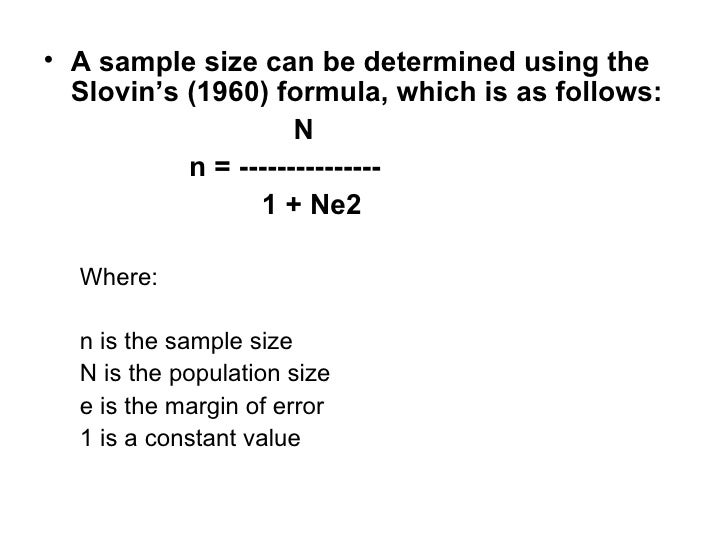
Simple random samples (practice) Khan Academy
sampling has confident points of having improvement over the simple random sample, as ample the systematic sample is feast more equally completed to the complete population. The execution of the method is very easy, less in cost and conveniently to use in case of a larger population. Stratified sampling Is applied when population from which sample to be drawn from the group does not have
Sampling Theory| Chapter 2 Simple Random Sampling Shalabh, IIT Kanpur Page 1 Chapter -2 Simple Random Sampling Simple random sampling (SRS) is a method of selection of a sample comprising of n number of sampling units out of the population having N number of sampling units such that every sampling unit has an equal chance of being chosen.
In order to carry out random sampling properly, strict procedures need to be adhered to. Random sampling techniques can be split into simple random sampling and systematic sampling. 2.3 Simple Random Sampling If selections are made purely by chance this is known as simple random sampling.
Disadvantages of Simple random sampling. Simple random sampling suffers from the following demerits: 1. This method carries larger errors from the same sample size than that are found in stratified sampling. 2. In simple random sampling, the selection of sample becomes impossible if the units or items are widely dispersed. 3.
Practice using tables of random digits and random number generators to take a random sample. If you’re seeing this message, it means we’re having trouble loading external resources on our website. If you’re behind a web filter, please make sure that the domains *.kastatic.org and *.kasandbox.org are unblocked.
09/11/2016 · Techniques for generating a simple random sample. View more lessons or practice this subject at http://www.khanacademy.org/math/ap-statistics/gathering-data-…
Simple random sampling is the most basic and common type of sampling method used in quantitative social science research and in scientific research generally. The main benefit of the simple random sample is that each member of the population has an equal chance of being chosen for the study.This means that it guarantees that the sample chosen is representative of the population and that the
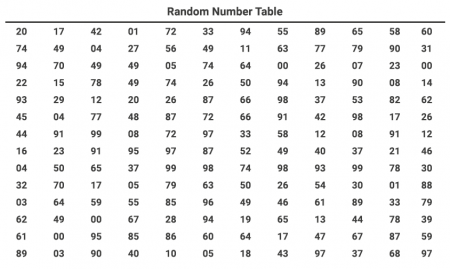
If a simple random sample selection scheme is used in each stratum then the corresponding sample is called a stratified random sample. Reasons for stratification. • To obtain estimates of known precision for certain subdivisions of the population by treating each subdivision as a stratum. Since sampling is done independently in each stratum
Distinguishing Between a Sample and a Population Simple Random Sampling Step 1. Defining the Population Step 2. Constructing a List Step 3. Drawing the Sample Step 4. Contacting Members of the Sample Stratified Random Sampling Convenience Sampling Quota Sampling Thinking Critically About Everyday Information Sample Size Sampling Error
sample size allocation, stratified sampling can have larger sampling variance than the simple random sampling. Another advantage of proportional allocation is that the sampling weights are all equal. A sampling design that has equal sampling weights is called self-weighting design. Self weighting is very convenient and popular in practice. Now, consider another allocation method, which is
A simple random sample is a subset of a statistical population in which each member of the subset has an equal probability of being chosen. A simple random sample is meant to be an unbiased
Simple random sampling is defined as a technique where there is an equal chance of each member of the population to get selected to form a sample. Simple random sampling is a probability sampling technique. Learn more with simple random sampling examples, advantages and disadvantages.
An Unbiased Estimator of the Variance of Simple Random Sampling Using Mixed Random-Systematic Sampling * Alberto Padillay Banco de M¶exico Abstract Systematic sampling is a commonly used technique due to its simplicity and ease of imple-mentation. The drawback of this simplicity is that it is not possible to estimate the design variance
In this tutorial we will learn how to create sampling in Excel. We will explain how to create a simple random sampling in excel and periodic sample in Excel. Simple Random Sampling: Selecting random number of data from the dataset with repetition. Periodic sampling: A periodic sampling method selects every nth item from the data set.
Simple Random Sampling Moulinath Banerjee University of Michigan September 11, 2012 1 Simple Random Sampling The goal is to estimate the mean and the variance of a variable of interest in a nite population by collecting a random sample from it. Suppose there are N members of the
Random Sampling Formula Statistics. Answer: That’s what it takes to So we really need to use the For example, given a simple random sample, researchers can use Random Sampling Formula Calculator such that every one of the distinct samples has an equal chance of being drawn. The sample mean for random sampling with or without from a random
Several efficient algorithms for simple random sampling have been developed. A naive algorithm is the draw-by-draw algorithm where at each step we remove the item at that step from the set with equal probability and put the item in the sample. We continue until we have sample of desired size k. The drawback of this method is that it requires random access in the set.
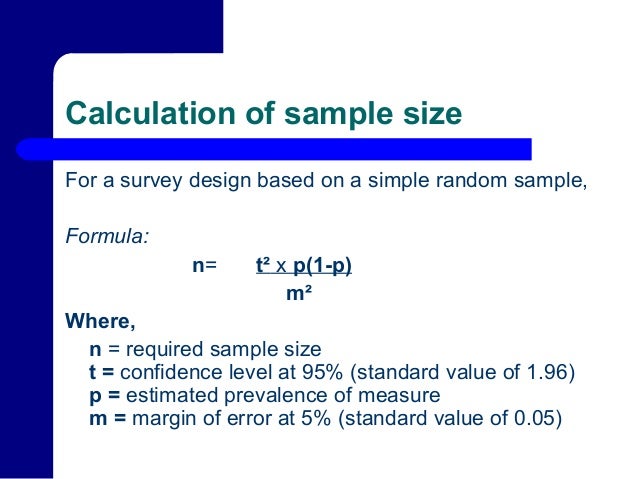
Continuing with our series of posts on sampling, today we’ll review the first random sampling method: simple random sampling.This is one of the most popular sampling methods, and it serves as a reference for many others, even though, as we’ve said before, in practice it can be difficult to implement.
Sample Size: Simple Random Samples. This lesson describes how to find the smallest sample size that provides the desired precision, when the sampling method is simple random sampling. Factors That Influence Sample Size. The “right” sample size for a particular application depends on many factors, including the following:
To draw a probability sample, we begin by identifying the population of interest. The next step is to create the “sampling frame,” a list of units to be sampled. One easy design is “simple random sampling.” For instance, to draw a simple random sample of 100 units, choose one unit
This paper introduces a sampling plan for finite populations herein called “variable size simple random sampling” and compares properties of estimators based on it with results from the usual
In other words, simple random sampling is a method of selecting a sample s of n units from a population Ω of size N by giving equal probability of selection to all units. It is a sampling scheme in which all possible combinations of n units may be formed from the …
History of Sampling (Contd) Dates back to 1920 and started by Literary Digest, a news magazine published in the U.S. between 1890 and 1938. Digest successfully predicted the presidential elections in 1920, 1924,1928, 1932 but; Failed in 1936… The Literary Digest poll in 1936 used a sample of 10 million, drawn from government lists of automobile and telephone
What is the formula for simple random sampling? Asked in . Statistics. Ecology and Bionomics. What is the formula for simple random sampling? We need you to answer this question! If you know the
Simple random sampling means that every member of the population has an equal chance of being included in the study. In the candy bar example, that means that if the scope of your study population is the entire United States, a teenager in Maine would have the same chance of being included as a grandmother in Arizona.
Simple Random Sampling Naval Postgraduate School
Sample question: Use Slovin’s formula to find out what sample of a population of 1,000 people you need to take for a survey on their soda preferences. Step 1: Figure out what you want your confidence level to be. For example, you might want a confidence level of 95 percent (giving you an alpha level of 0.05), or you might need better accuracy at the 98 percent confidence level (alpha level
higher precision that a simple random sample for the same amount of effort. The first of these designs is stratified random sampling. A stratified random sample is one obtained by dividing the population elements into mutually exclusive, non-overlapping groups of sample units called strata, then selecting a simple random
• Simple random sampling (SRS) occurs when every sample of size n (from a population of size N) has an equal chance of being selected! – This is not how we will actually draw such a sample, just how it’s defined! • Note it is not defined as each element having an equal chance of being selected!
2.3 Simple Random Sampling Simple random sampling without replacement (srswor) of size nis the probability sampling design for which a xed number of nunits are selected from a population of N units without replacement such that every possible sample of nunits has equal probability of being selected. A resulting sample is called a simple random
sampling design increases precision compared to simple random sampling (stratified sampling, for instance, increases precision). Unfortunately, most computer programs generate significance coefficients and confidence intervals based on the assumption of formulas for simple random sampling. Formulas …
Yet in practice, most simple random samples are drawn without replacement, since we want to avoid the strange assumption of one person being tallied as two or more. To resolve this disparity between st atistical theory and practice, the variance formulas used in simple random sampling are changed somewhat, as described next.
Simple random sampling. Simple random sampling is a type of probability sampling technique [see our article, Probability sampling, if you do not know what probability sampling is]. With the simple random sample, there is an equal chance (probability) of selecting each unit from the population being studied when creating your sample [see our article, Sampling: The basics, if you are unsure
Methods in Sample Surveys Simple Random Sampling Systematic Sampling Lecture 2. Saifuddin Ahmed, MBBS, PhD. Biostatistics Department. School of Hygiene and Public Health
How To Fix Standard Error In Simple Random Sampling Tutorial
many of these formulas in the original adaptation of this class. However, the formula style has been converted to be in line with that found in Cochran’s Sampling Techniques. A number of other popular survey sampling books also have a wide variety of styles. But they all seem to reflect the same formulas that at first glance look quite
Data Sampling in Excel – Create Random Sample in Excel

Chapter 4 Simple random samples and their properties
Simple random sampling Lærd Dissertation
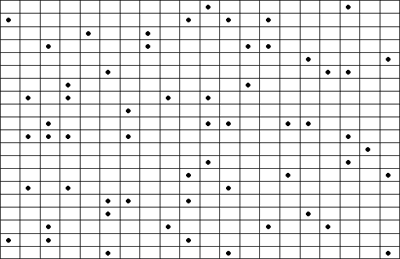
2.3 Simple Random Sampling Montana State University
Sample Size Formulas for our Sample Size Calculator

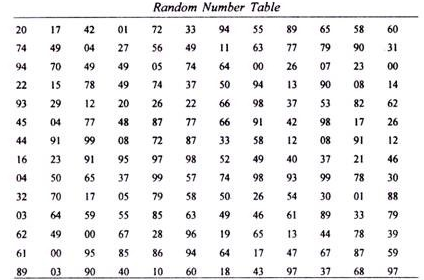
Chapter2 Simple Random Sampling – IIT Kanpur
Simple Random Sampling SpringerLink
Simple Random Sampling Statistics

What is the formula for simple random sampling Answers
Advantages & Disadvantages of Simple Random Sampling